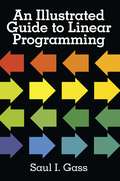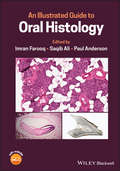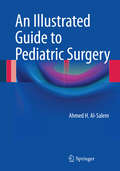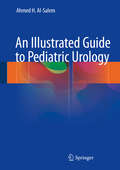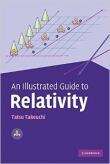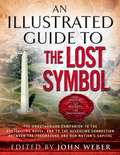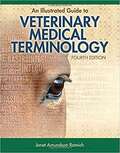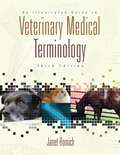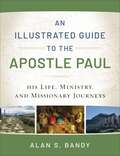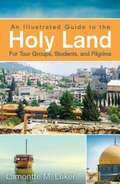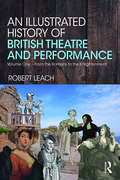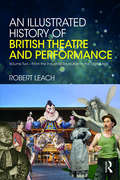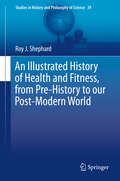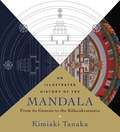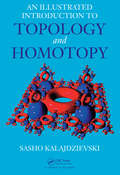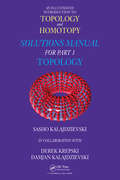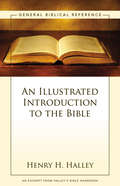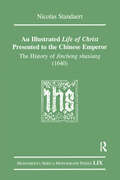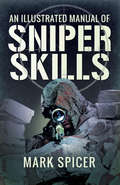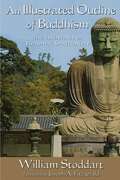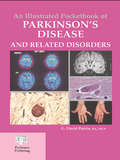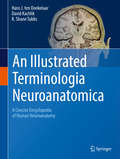- Table View
- List View
An Illustrated Guide to Linear Programming
by Dr Saul I. Gass"I would not hesitate to recommend the book." -- Industrial Engineering. Entertaining, nontechnical introduction covers basic concepts of linear programming and its relationship to operations research; geometric interpretation and problem solving, solution techniques, network problems, much more. Appendix offers precise statements of definitions, theorems, and techniques, additional computational procedures. Only high-school algebra needed. Bibliography.
An Illustrated Guide to Oral Histology
by Paul Anderson Saqib Ali Imran FarooqLearn more about the histological presentation of diseased and normal oral tissues with this high definition illustrated dental reference An Illustrated Guide to Oral Histology delivers a collection of high-definition histological and pathological images, presenting both diseased and normal oral tissues. The book provides over 200 high-magnification histomicrographs of oral tissues, as well as definitions and explanations of key identifying histological and pathological features of oral tissues. Readers will also benefit from explanations of the clinical significance of particular features, numerous images of ground sections, haemotoxylin- and eosin-stained sections, and electron images. It also includes core topics such as: An introduction to tooth development, including the bud, cap, early bell, and late bell stages A thorough exploration of enamel, dentin, cementum and dental pulp A discussion of the periodontal ligament, including alveolar crest fibers, horizontal, oblique, apical, and inter-radicular fibers, transseptal fibers, and gingival fibers A guide to alveolar bone, oral mucosa, and salivary glands Perfect for postgraduate dental students, An Illustrated Guide to Oral Histology will also be useful to undergraduate dental students, and those looking to improve their understanding of the microscopic structure of dental tissues and their pathologies.
An Illustrated Guide to Pediatric Surgery
by Ahmed H. Al-SalemWritten in a simple point by point style for ease of use, this volume covers all aspects of pediatric surgery with emphasis on important points for diagnosis and management. Each chapter covers a topic with emphasis on the most common conditions in neonatal and general pediatric surgery. The text is well illustrated with clinical, operative, radiological, and histopathological color figures and illustrations. The book also presents some of the rare conditions encountered in pediatric surgery, as well as common pediatric urology conditions. An Illustrated Guide to Pediatric Surgery is a useful reference to pediatric surgeons, specialists, fellows and residents, as well as general surgeons, pediatricians, neonatologists, medical students and interns interested in pediatric surgery.
An Illustrated Guide to Pediatric Urology
by Ahmed H. Al-SalemThis book is vital for physicians caring for young patients with urological conditions, as a quick reference book that is easy to read and well-illustrated. Pediatric urological conditions are fairly common, and infants and children are seen on daily basis with urological problems either in clinics or in hospitals. This book is useful to general surgeons, pediatricians, pediatric surgeons, fellows, residents, general physicians and family physicians, medical students and nurses. The Editor has gained experience in the diagnosis and management of various urological problems in infants and children, working in busy hospital over the last 25 years.
An Illustrated Guide to Relativity
by Tatsu TakeuchiAimed at both physics students and non-science majors, this unique book explains Einstein's special theory of relativity pictorially, using diagrams rather than equations. The diagrams guide the reader, step-by-step, from the basics of relativity to advanced topics including the addition of velocities, Lorentz contraction, time dilation, the twin paradox, Doppler shift, and Einstein's famous equation E=mc2. The distinctive figures throughout the book enable the reader to visualize the theory in a way that cannot be fully conveyed through equations alone. The illustrative explanations in this book maintain the logic and rigour necessary for physics students, yet are simple enough to be understood by non-scientists. The book also contains entertaining problems which challenge the reader's understanding of the materials covered.
An Illustrated Guide to The Lost Symbol
by John WeberRich in world history and political power, veiled in secrecy, and rife with rituals and arcane symbols -- from art and architecture to the images that adorn our currency -- the Freemasons arose from ambiguous origins centuries ago to play a major role in drafting the initial documents of the United States, and even in constructing the intricate landscape of Washington, D.C., itself a virtual mystery by design. These puzzles lay the foundation for Dan Brown's serpentine thriller, The Lost Symbol, and also raise provocative questions. Why do some Masonic symbols remain obscured, while others are hidden in plain sight? Which presidents were the embodiments of Masonic ideals? What is the significance of the construction of the Library of Congress, Washington National Cathedral, the Washington Monument, the Capitol, and the physical layout of Washington, D.C.'s roadways and cul-de-sacs? And to what secretive end do they all lead? Now millions of curious fans can follow Robert Langdon step-by-step, and discover for themselves the answers to the absorbing conundrums posed by The Lost Symbol in this comprehensive, fully illustrated, and intricately detailed tour of the arcana of Washington, D.C. It takes readers through the enigmatic codes, captivating trivia, unfathomable riddles, intriguing records, historic maps, ciphers, and conspiracies of the phenomenal bestseller. What's more, it reveals the fascinating details of a world of unknown locales, mysticism, intrigue, and secret societies -- all of which lie in the shadow of The Lost Symbol.
An Illustrated Guide to Veterinary Medical Terminology
by Janet Amundson RomichProviding the ultimate terminology reference for veterinary assistants and technicians, AN ILLUSTRATED GUIDE TO VETERINARY MEDICAL TERMINOLOGY, 4e provides an engaging, systematic approach to learning medical terms and understanding basic principles of veterinary medicine. This user-friendly textbook delivers a unique pedagogical presentation that makes it a comprehensive learning resource. Focusing on how medical terms are formed, analyzed, and defined, the text discusses anatomical landmarks, the positioning of animals, and the relationships between body parts. It also introduces terms used in the animal industry. Case studies illustrate how medical terminology is experienced in real-world practice, and an audio wordlist enables readers to hear the terms they are learning.
An Illustrated Guide to Veterinary Medical Terminology (3rd edition)
by Janet Amundson RomichA systematic approach to breaking down the parts of medical terms is used, allowing readers to grasp basic medical concepts and apply critical thinking skills when faced with new and unfamiliar medical terminology.
An Illustrated Guide to the Apostle Paul: His Life, Ministry, And Missionary Journeys
by Alan S. BandyThis fascinating, full-color visual guide to the life of Paul explores the social, cultural, political, religious, and historical background of the world in which he lived and ministered, offering modern readers an engaging narrative of the man who laid the foundations of the first-century church.
An Illustrated Guide to the Holy Land for Tour Groups, Students, and Pilgrims
by Lamontte M. LukerAs the geographic heart and soul of Judaism, Islam, and Christianity, the Holy Land has immense significance for the millions of visitors each year. But since the fifth century BC, enthusiastic and curious people have needed a guide as they travel to see the sites for themselves.This book is different because it not only gives the historical, archaeological descriptions wedded to the biblical text, but it is an appropriate resource for spiritual formation and cross-cultural dialog.Packed with the latest information, this book locates and introduces the reader to popular and less-familiar sites such as Bethlehem, Shepherds’ Field, Church of the Nativity, Roman Catholic Church of St. Catherine, the Herodium, Mount of Olives, Old City of Jerusalem, Wadi Kelt, Mt. Sinai, Church of the Holy Sepulchre, the site of Church of St. Mary of the Latins, Temple Mount, El-Aksa Mosque, Dome of the Rock, Hezekiah's Tunnel, the traditional place of the Last Supper, Siloam Pool, the traditional tomb of King David, the house of Caiphas the High Priest, Shrine of the Book, Herod's Antonio Fortress, Golgotha, Bethany, Tomb of Lazarus, Bethphage, Pater Noster Church, Gethsemane, and many others. Each entry explains the history and topography of the site as well as its function and significance as it is linked to the relevant biblical passages.This book will not only inform you but help you better understand your faith. Journey to the Holy Land with indispensable archaeological information linked to the biblical story.
An Illustrated Handbook of Horse and Pony Care
by Tim Hawcroft Jane KiddAnyone who owns a horse or who works with horses and ponies knows the importance of ensuring that they are healthy, well-behaved, and well-disciplined. This is more easily said than done; like humans, horses are individuals and they often have specific care and management problems. Some of these problems are inherent in their physiological makeup; others may be man-made because of the environment provided. Still others may be caused by accident or by infection. The Illustrated Encyclopedia of Horse and Pony Care is an authoritative and practical guide to all aspects of looking after the horse and pony. It is designed to meet the needs and stimulate the interests of anyone involved with horses and ponies - from parents buying their child's first pony to breeders and trainers. The book is divided into four main sections, beginning with Buying a Horse. Each aspect for consideration in this section is presented on a double- page spread including conformation, temperament, and identification. Color photographs are combined with superb color paintings to provide a thorough guide to colors and natural markings. The second section, Handling the Horse, includes step-by-step instructions and accompanying photographs on how to approach, catch, and lead a horse; various methods of restraint for adults and foals; how to transport your horse by road, rail, sea, or air. There are beautifully detailed illustrations showing the various types of saddles and bridles, sequences of color photographs showing the correct way to put on the tack, and useful advice on how to care for this valuable equipment. The next section which is the main focus of the book, concerns the healthy horse. Guidelines are set out for daily care, including feeding, grooming, and exercise with important points presented in charts for quick and easy reference. Periodic care includes worming and teeth care, with chapters on shoeing and vaccination. Vital first-aid techniques are explained with clear, easy-to-follow instructions. One of the most important features of the book is its coverage of specific health problems. Drawing on his extensive knowledge and sound veterinary practice, Tim Hawcroft has illustrated and enumerated the most common and easily-recognizable illnesses and accidents that a horse may suffer from. These diseases and problems are arranged from A-to-Z with details of signs, symptoms, and treatment given for each ailment. The fourth and final section of the book discusses breeding. There are chapters on selection and management of the stallion and mare; preparation for the service; pregnancy diagnosis including details of the latest ultrasound techniques; a series of color photographs illustrating the various stages of foaling; advice on how to care for the mare after foaling; common diseases and problems of foals with full details of treatment; and, finally, specific care requirements of youngstock.
An Illustrated History of British Theatre and Performance: Volume One - From the Romans to the Enlightenment
by Robert LeachAn Illustrated History of British Theatre and Performance chronicles the history and development of theatre from the Roman era to the present day. As the most public of arts, theatre constantly interacts with changing social, political and intellectual movements and ideas, and Robert Leach’s masterful work restores to the foreground of this evolution the contributions of women, gay people and ethnic minorities, as well as the theatres of the English regions, and of Wales and Scotland. Highly illustrated chapters trace the development of theatre through major plays from each period; evaluations of playwrights; contemporary dramatic theory; acting and acting companies; dance and music; the theatre buildings themselves; and the audience, while also highlighting enduring features of British theatre, from comic gags to the use of props. This first volume spans from the earliest forms of performance to the popular theatres of high society and the Enlightenment, tracing a movement from the outdoor and fringe to the heart of the social world. The Illustrated History acts as an accessible, flexible basis for students of the theatre, and for pure fans of British theatre history there could be no better starting point.
An Illustrated History of British Theatre and Performance: Volume Two - From the Industrial Revolution to the Digital Age
by Robert LeachAn Illustrated History of British Theatre and Performance chronicles the history and development of theatre from the Roman era to the present day. As the most public of arts, theatre constantly interacted with changing social, political and intellectual movements and ideas, and Robert Leach’s masterful work restores to the foreground of this evolution the contributions of women, gay people and ethnic minorities, as well as the theatres of the English regions, and of Wales and Scotland. Highly illustrated chapters trace the development of theatre through major plays from each period; evaluations of playwrights; contemporary dramatic theory; acting and acting companies; dance and music; the theatre buildings themselves; and the audience, while also highlighting enduring features of British theatre, from comic gags to the use of props. Continuing on from the Enlightenment, Volume Two of An Illustrated History of British Theatre and Performance leads its readers from the drama and performances of the Industrial Revolution to the latest digital theatre. Moving from Punch and Judy, castle spectres and penny showmen to Modernism and Postdramatic Theatre, Leach’s second volume triumphantly completes a collated account of all the British Theatre History knowledge anyone could ever need.
An Illustrated History of Duke Basketball: A Legacy of Achievement
by Mike Krzyzewski Ben Cohen Bill BrillNo college in America has dominated the basketball scene the way Duke has. From the ?rst game in 1906 through the NCAA National Championship following the 2009-10 season, 100 Seasons of Duke Basketball provides fans with an insider's look at Duke basketball and the people who have made it a national legend-Vic Bubas, Eddie Cameron, Art Heyman, Mike Krzyzewski, and many others.
An Illustrated History of Health and Fitness, from Pre-History to our Post-Modern World (Studies in History and Philosophy of Science #39)
by Roy J. ShephardThis book examines the health/fitness interaction in an historical context. Beginning in primitive hunter-gatherer communities, where survival required adequate physical activity, it goes on to consider changes in health and physical activity at subsequent stages in the evolution of "civilization. " It focuses on the health impacts of a growing understanding of medicine and physiology, and the emergence of a middle-class with the time and money to choose between active and passive leisure pursuits. The book reflects on urbanization and industrialization in relation to the need for public health measures, and the ever-diminishing physical demands of the work-place. It then evaluates the attitudes of prelates, politicians, philosophers and teachers at each stage of the process. Finally, the book explores professional and governmental initiatives to increase public involvement in active leisure through various school, worksite, recreational and sports programmes.
An Illustrated History of the Mandala: From Its Genesis to the Kalacakratantra
by Kimiaki TanakaEveryone’s heard of mandalas; now we have a uniquely rich history and explanation of their history and meaning.This book is a history of the genesis and development of the mandala from the fifth and sixth centuries, when the mandala first appeared in India, to the eleventh century, when the Kalacakratantra appeared just before the disappearance of Buddhism in India. The 600 years of Indian esoteric Buddhism that concluded the 1,700-year history of Indian Buddhism could be said to have been the history of the development of the mandala. (The Kalacakratantra integrated earlier mandala theories into a single system and established a monumental system unprecedented in the history of esoteric Buddhism. It was thus the culmination of the development of Indian Buddhism over a period of 1,700 years.) The analysis is at the micro level and includes numerous illustrations and charts. Particular attention is paid to proper names, mudras, and mantras that have been overlooked by scholars in philosophy and doctrine, and the author tackles issues that cannot be explained solely from a historical viewpoint, such as geometric patterns, the arrangement of deities, the colors, and their meaning in Buddhist doctrine.
An Illustrated Introduction to Topology and Homotopy
by Sasho KalajdzievskiAn Illustrated Introduction to Topology and Homotopy explores the beauty of topology and homotopy theory in a direct and engaging manner while illustrating the power of the theory through many, often surprising, applications. This self-contained book takes a visual and rigorous approach that incorporates both extensive illustrations and full proofs
An Illustrated Introduction to Topology and Homotopy Solutions Manual for Part 1 Topology
by Sasho Kalajdzievski Derek Krepski Damjan KalajdzievskiThis solution manual accompanies the first part of the book An Illustrated Introduction toTopology and Homotopy by the same author. Except for a small number of exercises inthe first few sections, we provide solutions of the (228) odd-numbered problemsappearing in first part of the book (Topology). The primary targets of this manual are thestudents of topology. This set is not disjoint from the set of instructors of topologycourses, who may also find this manual useful as a source of examples, exam problems,etc.
An Illustrated Introduction to the Bible: A Zondervan Digital Short
by Henry H. HalleyDerived from Halley’s Bible Handbook, a world-renowned, accessible guide to the Bible now in its twenty-fifth edition, this digital short explains simply and clearly how the Bible was written and what it is about. Readers looking for a basic introduction to the Bible or wanting a tool to teach others about it will find An Illustrated Introduction to the Bible to be a handy resource.
An Illustrated Journey: Inspiration From the Private Art Journals of Traveling Artists, Illustrators and Designers
by Danny GregoryTravel + Sketching = InspirationWhen we travel, we don't want to follow the same itinerary as everyone who's come before us. We want to feel like explorers, adventurers in undiscovered territory. And that's exactly what sketching can bring to the travel experience.An Illustrated Journey captures the world through the eyes of 40 talented artists, illustrators and designers. You'll experience the wonder of seeing familiar sights through a fresh lens but, more important, you'll be inspired to set pen to paper and capture your own vistas.The really wonderful thing about a sketchbook is that it can be totally private. You don't have to have an ounce of talent to enjoy learning how to really see what's in front of you. But lucky for us, the sketchbooks captured here are lovely, creative, intimate windows into each artist's mind.So, whether you're just returning to the art of drawing, abandoned by most of us after childhood, or you're looking for inspiration to take your illustration work in a new direction, An Illustrated Journey will take you on a wonderful trip of the imagination. All you need to pack are a pencil and a piece of paper.
An Illustrated Life of Christ Presented to the Chinese Emperor: The History of Jincheng shuxiang (1640) (Monumenta Serica Monograph Series)
by Nicolas StandaertA renewed attention to visual culture is one of the recent developments in the study of cultural contacts between China and Europe in the seventeenth and eighteenth centuries. The subject of this book is the illustrated Life of Christ presented to the Chinese emperor in 1640 by the Jesuit missionary Johann Adam Schall von Bell S.J. (1592-1666). The origin of the work is a small parchment booklet with coloured miniature paintings based on a wide variety of prints by well-known European engravers (e.g., H. Goltzius, J. Stradanus). It was compiled in Munich in 1617 and a Chinese version with the title Jincheng shuxiang was published in Beijing more than twenty years later in a nicely illustrated edition. An Illustrated Life of Christ is a fascinating analysis of one of the earliest artistic encounters between Europe and China...Standaert has, once again, demonstrated his scholarly foresight, workmanship and authority. John T.P. Lai in Journal of the History of Christianity in Modern China This book is composed of two parts. Part I traces the complex history of production of Jincheng shuxiang, from its European origin to its Chinese reception. It also analyses the illustrations and the text. Part II contains the reproduction of the Chinese text and 48 illustrations, the reproduction of the identified original European prints and a translation of the Chinese text. It is hoped that the wider diffusion of this rare primary source, which is now reprinted for the first time since the seventeenth century, will further stimulate the study of visual culture in Sino-Western relations. The book will be of interest to a broad range of scholars, from art historians of China and Europe to scholars interested in print history, and theologians.
An Illustrated Manual of Sniper Skills
by Mark SpicerThis heavily illustrated manual offers an in-depth look at the art of sniping in war and anti-terrorist environments. Drawing on a vast, firsthand knowledge of sniper skills, former British Army sniper and sniper instructor Mark Spicer describes the role of the sniper in peace and in war, in reconnaissance and counter-surveillance, in cities, in vehicles, at night and by day. He presents crucial information about training and equipment, judgment and positioning, details of great relevance to professional marksmen, both military and law enforcement. This comprehensive manual will also be of interest to hunters, weapons enthusiasts, competition shooters, and paintball participants. The authoritative text is complimented by 280 full color illustrations, diagrams, and related information.
An Illustrated Outline of Buddhism: The Essentials of Buddhist Spirituality
by William StoddartAnIllustrated Outline of Buddhism is an ideal introduction to the vast and complex field of Buddhism, a world religion with more than a billion followers. In its short format and accessible style, it presents the essential features of the Buddhist religion with a clear yet concise style that is suitable for both the general reader and student of Buddhism. This fully color edition contains 40 color illustrations, including a stunning array of outstanding examples of Buddhist art, architecture, statuary, and calligraphy. Numerous maps, diagrams, and charts are included to illustrate important aspects of Buddhist beliefs and to summarize the different cultural forms and developmental phases of Buddhism. A select bibliography for further reading and a detailed index will also aid the reader.
An Illustrated Pocketbook of Parkinson's Disease and Related Disorders
by G. David PerkinAn authoritative introduction to Parkinson's disease and its related disorders and syndromes, this book provides a concise overview of the disease and its diagnosis and management. The author presents samples of clinical, investigative (CT, MRI, and PET), and pathological images with succinct descriptive text of the disorders featured. He describes
An Illustrated Terminologia Neuroanatomica: A Concise Encyclopedia of Human Neuroanatomy
by R. Shane Tubbs Hans J. ten Donkelaar David KachlíkThis book is unique in that it provides the reader with the most up-to-date terminology used to describe the human nervous system (central and peripheral) and the related sensory organs, i.e., the Terminologia Neuroanatomica (TNA), the official terminology of the IFAA (International Federation of Associations of Anatomists). The book provides a succinct but detailed review of the neuroanatomical structures of the human body and will greatly benefit not only various specialists such as (neuro)anatomists, neurologists and neuroscientists, but also students taking neuroanatomy and neuroscience courses. The book offers a high yield, combined presentation of neuroanatomical illustrations and text and provides the reader a ‘one-stop source’ for studying the intricacies of the human nervous system and its sensory organs. It includes an alphabetical list of official English terms and synonyms with the official Latin terms and synonyms from the TNA. With regard to the entries, the name of the item in standardized English is provided, followed by synonyms and the official TNA Latin term, Latin synonyms and eponyms, a short description and in many cases one or more illustrations. To facilitate the use of illustrations, certain entries such as the gyri or sulci of the cerebral cortex are presented together with extensive cross-references. Terms that form part of a certain structure (such as the amygdaloid body, the thalamus and the hypothalamus) are listed under the respective structure. Segments and branches of arteries are discussed under the main artery, for example the A1–A5 segments under the anterior cerebral artery. Most nerves can be found following their origin from the brachial, cervical and lumbosacral plexuses. However, the major nerves of the limbs are discussed separately, as are the cranial nerves. Nuclei can be found by their English name or under Nuclei by their eponym.
